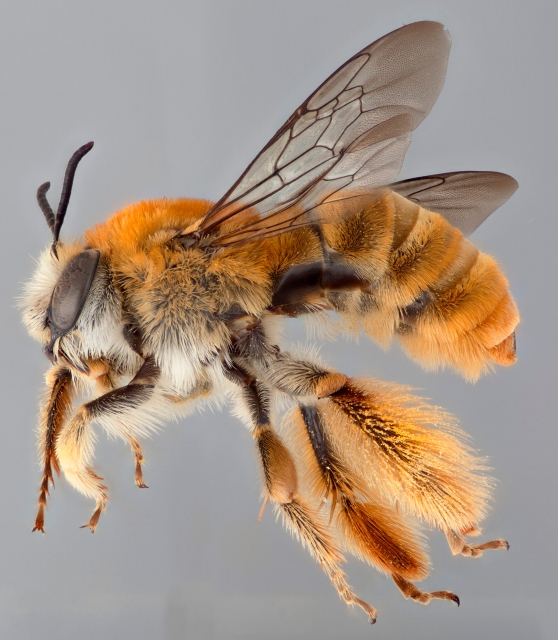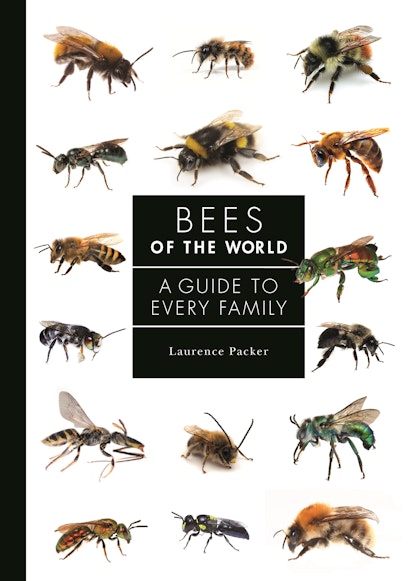When many people think of bees, they are likely to picture the western domesticated honey bee, insects that live in large, socially complex societies inside a hive with a single queen and thousands of workers. But this familiar bee is just one of more than 20,000 species of bees—and almost none of the others is anything like it. In Bees of the World, Laurence Packer, one of the world’s foremost experts on wild bees, celebrates the amazing diversity of bees—from size and appearance to nests and social organization.
Why do we need a book that is about bee diversity?
LP: Because bees aren’t what most people think they are. The archetypal bee is the western domesticated honey bee (Apis mellifera)—which is just one among over 20,500 different species of bees. Few realise there are so many species or that our honey bee is such an unusual one.
In what way is it unusual?
LP: Honey bees live in hives in which there is a complex society with a queen and thousands of workers with sophisticated modes of communication among individuals. Furthermore, the colony lasts for multiple years. Most other bee species live solitary lives with each female entirely alone, usually nesting in a burrow they dig in the ground or in a tunnel in a pithy stem or in wood. These females may be active for only a few weeks. As solitary insects, there are no queens, no workers and no need for communication (other than to attract a mate and perhaps frighten off potential usurpers trying to take over the nest). There are a few hundred other bees with complex social lives like honey bees, less than a dozen of which are other species of Apis that live in similar societies. There are also the stingless bees of the tropics (and lacking a sting is another unexpected feature of many bees) with complex social lives and communication skills and colonies that last for years. There are also some bees with annual colonies, started in spring by one or a few females, with one or more broods of workers during the summer. In these, the males and next year’s queens are produced late in summer and the colonies die out. This colony cycle is found in the bumble bees and in some species of a relatively obscure group of bees that are often called sweat bees because they are attracted to human sweat. Some other bees share nests with all individuals being equal—each female collecting pollen and nectar for their offspring and each laying eggs on the pollen ball they construct inside a brood cell that they have excavated. They only share the nest entrance. But, despite such social diversity, the vast majority of bees are solitary.
If bees are so diverse, how does someone tell whether an insect they see is a bee?
LP: That’s actually very difficult without quite a lot of practice. Bees arose from a lineage of wasps that became vegetarian, collecting pollen and nectar, rather than other insects, as food for their offspring. It is not surprising that some bees look like wasps and vice versa, because of their shared evolutionary history. But some wasps (and other insects) look like bees also because of mimicry—anything that looks like an insect that has a ferocious sting will be avoided by birds and other predators so there’s safety in numbers when multiple species look alike.
But to answer the question: any insect that is collecting pollen and storing it on their legs or underneath their abdomen will be a bee. But that doesn’t help if the bee is a male, one of the bees that stores pollen in its digestive system or a cuckoo bee that lays its eggs on the food collected by individuals of a host species. To recognise those takes practice and you have to get to know the different groups individually to tell them apart from other insects.
If you have a specimen that you are interested in, the best way to tell if it is a bee or not is to look for branched hairs, all bees have branched hairs somewhere on their body, although sometimes you have to look hard to find them, even with a microscope.
Some bees are cuckoos?
LP: Yes, perhaps 15% of all bee species lay their eggs in the nests made by other bees, entering the nest while the host is out foraging or gaining access after the host has finished the nest. Another more than 50 species are social parasites—where the host is a social bee and the parasite coexists inside its host’s nest laying eggs on food collected by the workers of a different species.
With all this diversity are there some truly bizarre lifestyles among the bees?
LP: Yes, there are many ways in which different bees exhibit remarkably different behaviours. There are some that collect oil instead of nectar and others that get protein from carrion or vertebrate tears as a food source for the young. There are robber bees—these are social bees that steal food and nest constructing material from different species of social bee. One species of sweat bee has colonies that last for five or six years with the queens living for about twice as long as the queens of honey bees. Then there are unusual nest sites: the world’s largest (at least the longest) bee makes nests out of resin constructed inside the nests of arboreal termites. Some bees nest in empty snail shells and others are so diverse in the cavities that they can use as a nest site that they have been found in doctor’s stethoscopes, locks on doors or fuel lines of crashed aeroplanes (to name just a few unusual locations).
But even with this great diversity, isn’t it true that the only bee that matters for humans is the honey bee?
LP: The answer to that question is a definite no. Every year more research is published showing that “wild” bees are as important, or more important, than honey bees for crop pollination. Yet usually, all that crop yield (for crops that require pollination) is attributed to honey bees. Passion fruit is best pollinated by carpenter bees, blueberries are best pollinated by a wide range of solitary bees. Even beef and dairy benefits more from wild bees than honey bees because, in some countries at least, alfalfa is an important winter fodder for cattle and honey bees are poor pollinators of their flowers whereas, as its name suggests, the alfalfa leafcutter bee is a very good alfalfa pollinator and is used all over the world for that purpose.
There are also numerous benefits we get from wild bees pollinating wild plants: without the pollinators the flowers won’t produce seeds and berries, without seeds and berries a wide range of organisms (think of birds and bears perhaps) will suffer from reduced food supplies. Entire ecosystems benefit from the pollination efforts of bees and we benefit from well functioning ecosytems.
We hear a lot about colony collapse disorder affecting honey bees but are other bee species at risk?
LP: Yes, there is a lot of data demonstrating declines in populations of many wild bees. Bumble bees seem particularly affected by heat waves; bees that only collect pollen from one, or a few closely related, species of flowering plant are impacted by anything that reduces or fragments the populations of the flowers they depend upon; pesticides have negative impacts on wild bees as they do on our honey bees. Some bees are so rare that they’ve only been seen once, these might be extinct already and we will never know how important they may have been in their ecosystems. We need to conserve bees but before we can do that, we need to know what they are and most are quite different from what most people expect. I hope this book introduces people to the marvellous and important world of bee diversity.
Laurence Packer is one of the world’s leading experts on wild bees and the author of Keeping the Bees: Why All Bees Are at Risk and What We Can Do to Save Them. He is Distinguished Research Professor of Melittology at York University in Toronto and founder of the Packer Lab at York, a central global hub for wild bee research that has one of the fastest-growing bee collections in the world, with specimens from more than 100 countries.

